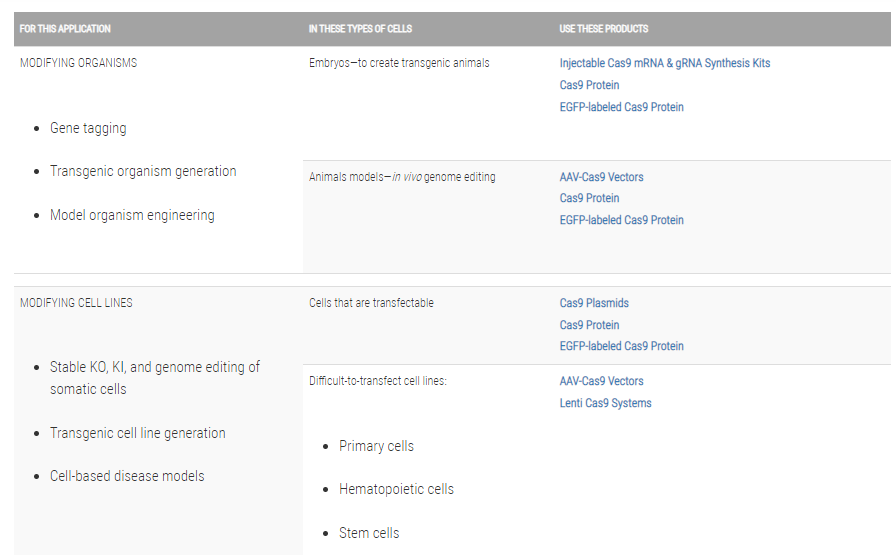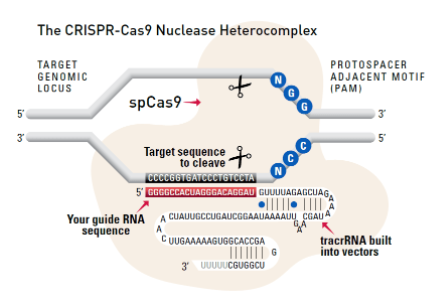System Biosciences
CMV-hspCas9-T2A-Puro-H1-AAVS1 gRNA SmartNuclease Pre-Packaged Lentiviral Particles [>10^6 IFUs]
- SKU:
- CASLV601VA-1
- Availability:
- Usually Shipped in 5 Working Days
- Size:
- 2 x 25ul
- Shipping Temperature:
- Dry Ice
Description
CMV-hspCas9-T2A-Puro-H1-AAVS1 gRNA SmartNuclease Pre-Packaged Lentiviral Particles [>10^6 IFUs]. Cat# CASLV601VA. Supplier: SBI System Biosciences


Overview

- Easy, precise knock-in of any gene
- Consistent, robust transgene expression from the AAVS1 Safe Harbor Site
- Simplified construction of isogenic cell lines
- Minimal off-target integration when using our AAVS1 HR Targeting Vectors
- Streamlined CRISPR/Cas9 library screening
Note that we’ve specially designed a series of AAVS1 HR Targeting Vectors that greatly reduce off-target integration events (Cat.# GE620A-1, GE622A-1, and GE624A-1). Taking advantage of the AAVS1's location within an intron, these vectors come with a puromycin marker that has no promoter, only a splice acceptor site—expression of puromycin can only occur when the construct integrates within an intron, reducing the probability of recovering off-target integrants in the presence of puromycin selection. As with all of our Cas9 delivery options, the All-in-one Cas9 SmartNuclease & AAVS1 gRNA Plasmid is functionally validated and comes backed by our expert technical support team—if you’ve got a genome engineering question just ask by emailing tech@systembio.com.
Not sure whether you need a CRISPR/Cas9 plasmid, purified protein, or mRNA?
Use this table to choose the CRISPR/Cas9 product that’s right for you:


How It Works
Genome engineering with CRISPR/Cas9
For general guidance on using CRISPR/Cas9 technology for genome engineering, take a look at our CRISPR/Cas9 tutorials as well as the following application notes:
CRISPR/Cas9 Gene Knock-Out Application Note (PDF) »
CRISPR/Cas9 Gene Editing Application Note (PDF) »
CRISPR/Cas9 Gene Tagging Application Note (PDF) »
CRISPR/Cas9 Basics
Through careful selection of the target sequence and design of a donor plasmid for homologous
recombination, you can achieve efficient and highly targeted genomic modification with CRISPR/Cas9.
The system

Cas9 protein—uses guide RNA (gRNA) to direct site-specific, double-strand DNA cleavage adjacent to a protospacer adapter motif (PAM) in the target DNA.
gRNA—RNA sequence that guides Cas9 to cleave a homologous region in the target genome. Efficient cleavage only where the gRNA homology is adjacent to a PAM.
PAM—protospacer adapter motif, NGG, is a target DNA sequence that spCas9 will cut upstream from if directed to by the gRNA.
The workflow at-a-glance
DESIGN: Select gRNA and HR donor plasmids. Choice of gRNA site and design of donor
plasmid determines whether the homologous recombination event results in a knock-out,
knock-in, edit, or tagging.
CONSTRUCT: Clone gRNA into all-in-one Cas9 vector. Clone 5’ and 3’ homology arms into HR
donor plasmid. If creating a knock-in, clone desired gene into HR donor.
CO-TRANSFECT or CO-INJECT: Introduce Cas9, gRNA, and HR Donors into the target cells
using co-transfection for plasmids, co-transduction for lentivirus, or co-injection for mRNAs.
SELECT/SCREEN: Select or screen for mutants and verify.
VALIDATE: Genotype or sequence putative mutants to verify single or biallelic conversion.

![CMV-hspCas9-T2A-Puro-H1-AAVS1 gRNA SmartNuclease Pre-Packaged Lentiviral Particles [>10^6 IFUs] CMV-hspCas9-T2A-Puro-H1-AAVS1 gRNA SmartNuclease Pre-Packaged Lentiviral Particles [>10^6 IFUs]](https://cdn11.bigcommerce.com/s-i3n9sxgjum/images/stencil/608x608/products/12545/12809/sbi%2520system%2520biosciences_1633075021__00205.original__77085.1633076544.jpg?c=1)
![CMV-hspCas9-T2A-Puro-H1-AAVS1 gRNA SmartNuclease Pre-Packaged Lentiviral Particles [>10^6 IFUs] CMV-hspCas9-T2A-Puro-H1-AAVS1 gRNA SmartNuclease Pre-Packaged Lentiviral Particles [>10^6 IFUs]](https://cdn11.bigcommerce.com/s-i3n9sxgjum/images/stencil/608x608/products/12545/12809/sbi%20system%20biosciences_1633075021__00205.original__77085.1633076544.jpg?c=1)
![CMV-hspCas9-T2A-Puro-H1-AAVS1 gRNA SmartNuclease Pre-Packaged Lentiviral Particles [>10^6 IFUs] CMV-hspCas9-T2A-Puro-H1-AAVS1 gRNA SmartNuclease Pre-Packaged Lentiviral Particles [>10^6 IFUs]](https://cdn11.bigcommerce.com/s-i3n9sxgjum/images/stencil/608x608/products/12545/15447/Screenshot_2021-12-05_191711__56791.1638713858.png?c=1)
![CMV-hspCas9-T2A-Puro-H1-AAVS1 gRNA SmartNuclease Pre-Packaged Lentiviral Particles [>10^6 IFUs] CMV-hspCas9-T2A-Puro-H1-AAVS1 gRNA SmartNuclease Pre-Packaged Lentiviral Particles [>10^6 IFUs]](https://cdn11.bigcommerce.com/s-i3n9sxgjum/images/stencil/100x100/products/12545/12809/sbi%20system%20biosciences_1633075021__00205.original__77085.1633076544.jpg?c=1)
![CMV-hspCas9-T2A-Puro-H1-AAVS1 gRNA SmartNuclease Pre-Packaged Lentiviral Particles [>10^6 IFUs] CMV-hspCas9-T2A-Puro-H1-AAVS1 gRNA SmartNuclease Pre-Packaged Lentiviral Particles [>10^6 IFUs]](https://cdn11.bigcommerce.com/s-i3n9sxgjum/images/stencil/100x100/products/12545/15447/Screenshot_2021-12-05_191711__56791.1638713858.png?c=1)
![CMV-hspCas9-T2A-Puro SmartNuclease Pre-Packaged Lentiviral Particles [>10^6 IFUs] CMV-hspCas9-T2A-Puro SmartNuclease Pre-Packaged Lentiviral Particles [>10^6 IFUs]](https://cdn11.bigcommerce.com/s-i3n9sxgjum/images/stencil/590x590/products/12543/12807/sbi%2520system%2520biosciences_1633075021__00205.original__08428.1633076543.jpg?c=1)
![CMV-hspCas9-T2A-Puro SmartNuclease Pre-Packaged Lentiviral Particles [>10^6 IFUs] CMV-hspCas9-T2A-Puro SmartNuclease Pre-Packaged Lentiviral Particles [>10^6 IFUs]](https://cdn11.bigcommerce.com/s-i3n9sxgjum/images/stencil/590x590/products/12543/15547/Screenshot_2021-12-06_224845__32511.1638812975.png?c=1)


![MSCV-hspCas9-T2A-Puro SmartNuclease Pre-Packaged Lentiviral Particles [>10^6 IFUs] MSCV-hspCas9-T2A-Puro SmartNuclease Pre-Packaged Lentiviral Particles [>10^6 IFUs]](https://cdn11.bigcommerce.com/s-i3n9sxgjum/images/stencil/590x590/products/14066/14334/sbi%2520system%2520biosciences_1633075021__00205.original__92820.1633076780.jpg?c=1)
![CMV-hspCas9-EF1-GFP SmartNuclease Pre-Packaged Lentiviral Particles [>10^6 IFUs] CMV-hspCas9-EF1-GFP SmartNuclease Pre-Packaged Lentiviral Particles [>10^6 IFUs]](https://cdn11.bigcommerce.com/s-i3n9sxgjum/images/stencil/590x590/products/12539/12803/sbi%2520system%2520biosciences_1633075021__00205.original__41412.1633076543.jpg?c=1)
![CMV-hspCas9-EF1-GFP SmartNuclease Pre-Packaged Lentiviral Particles [>10^6 IFUs] CMV-hspCas9-EF1-GFP SmartNuclease Pre-Packaged Lentiviral Particles [>10^6 IFUs]](https://cdn11.bigcommerce.com/s-i3n9sxgjum/images/stencil/590x590/products/12539/15571/Screenshot_2021-12-07_223653__92966.1638898652.png?c=1)
![Cas9 Nickase: CMV-hspCas9(D10A)-T2A-Puro SmartNickase Pre-Packaged Lentiviral Particles [>10^6 IFUs] Cas9 Nickase: CMV-hspCas9(D10A)-T2A-Puro SmartNickase Pre-Packaged Lentiviral Particles [>10^6 IFUs]](https://cdn11.bigcommerce.com/s-i3n9sxgjum/images/stencil/590x590/products/12501/12765/sbi%2520system%2520biosciences_1633075021__00205.original__53274.1633076537.jpg?c=1)
![Cas9 Nickase: CMV-hspCas9(D10A)-T2A-Puro SmartNickase Pre-Packaged Lentiviral Particles [>10^6 IFUs] Cas9 Nickase: CMV-hspCas9(D10A)-T2A-Puro SmartNickase Pre-Packaged Lentiviral Particles [>10^6 IFUs]](https://cdn11.bigcommerce.com/s-i3n9sxgjum/images/stencil/590x590/products/12501/15496/CASLV205PA-1__77169.1638786899.png?c=1)